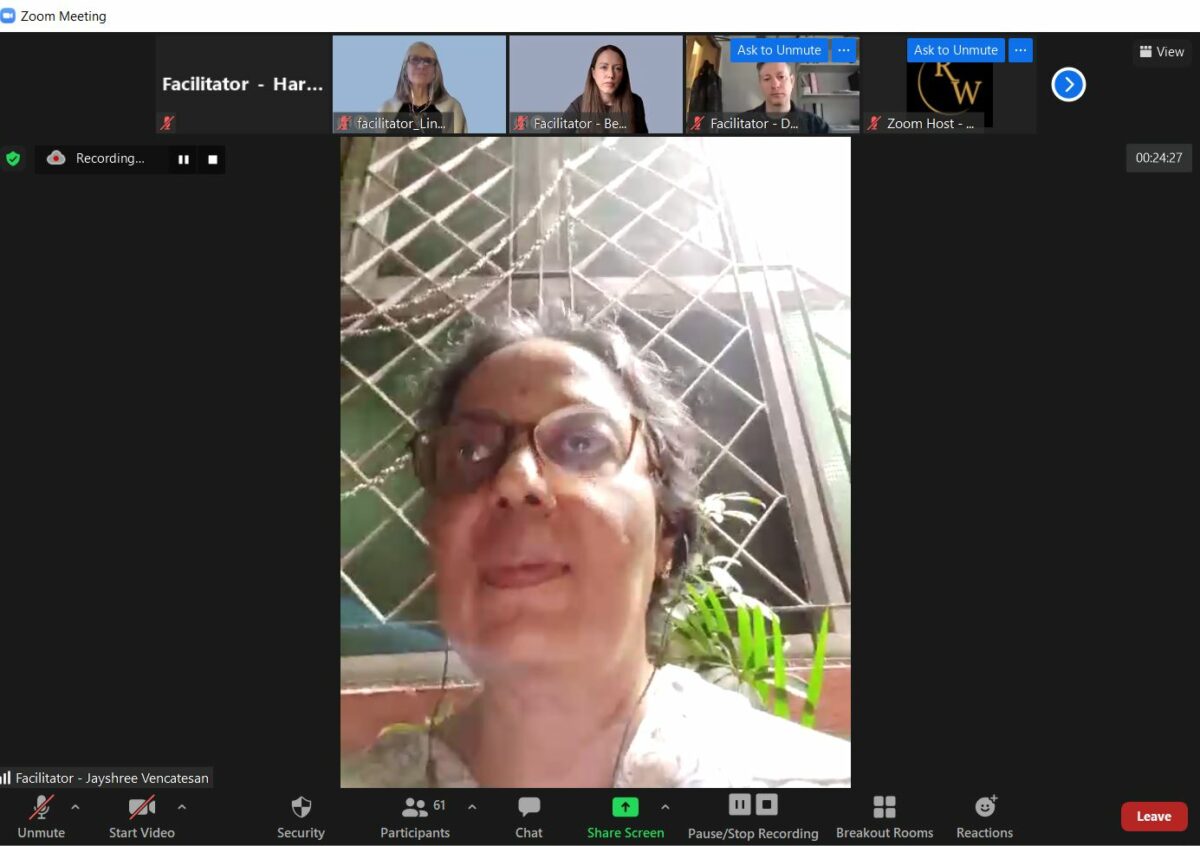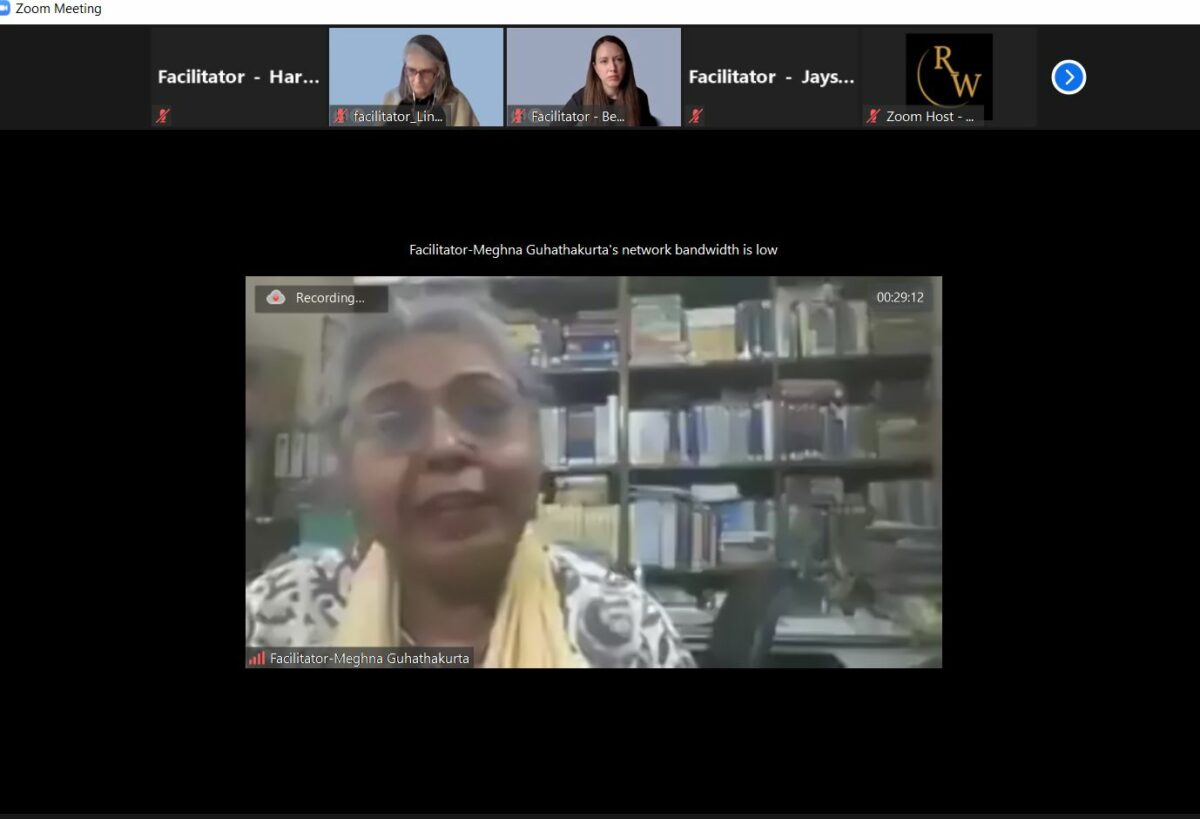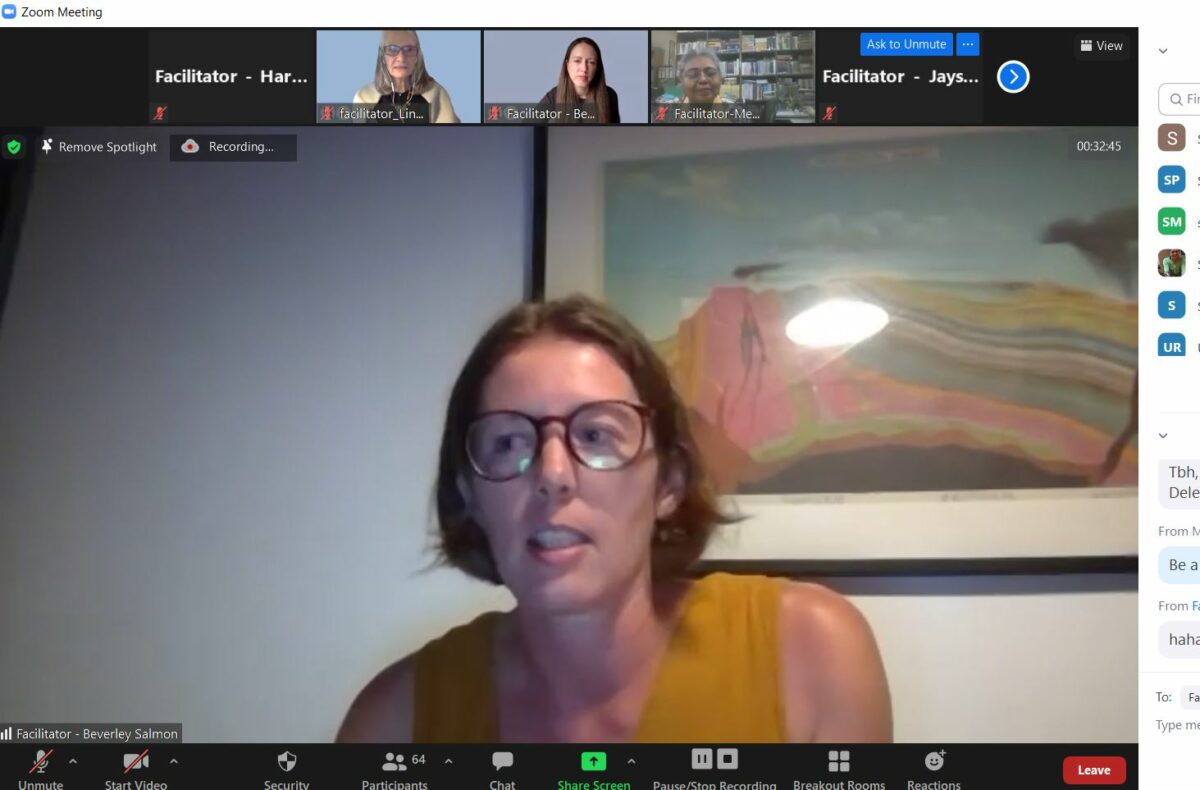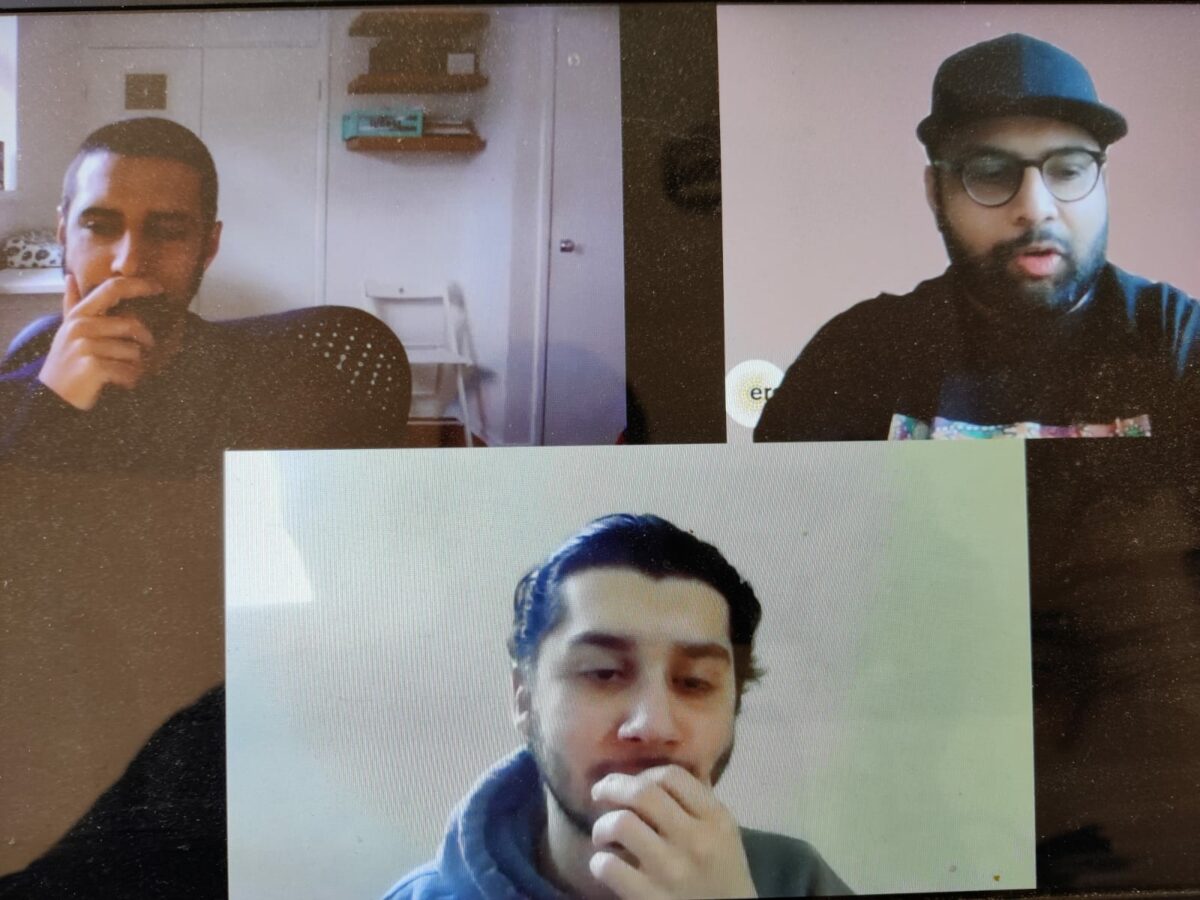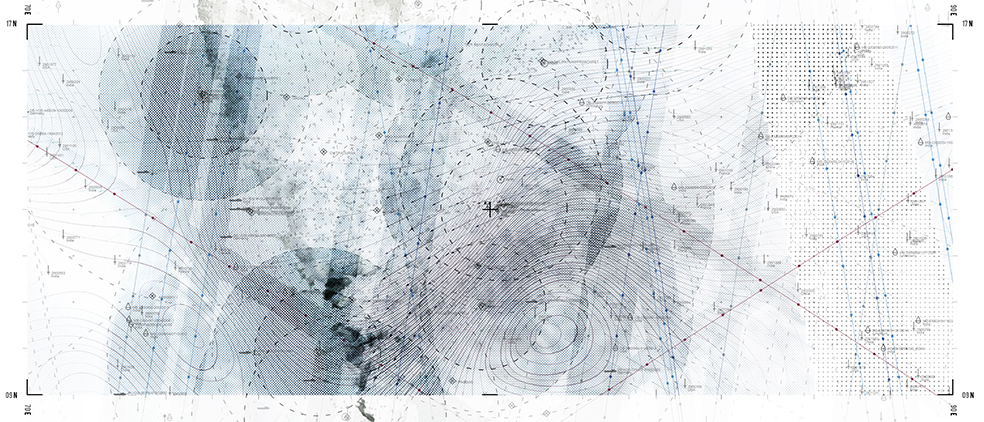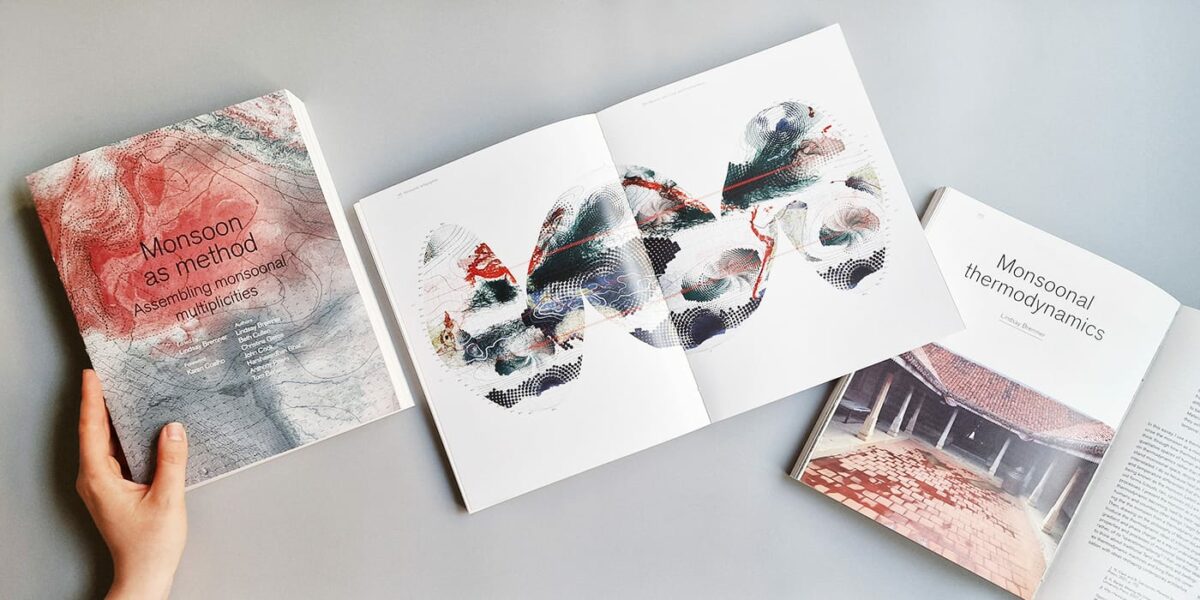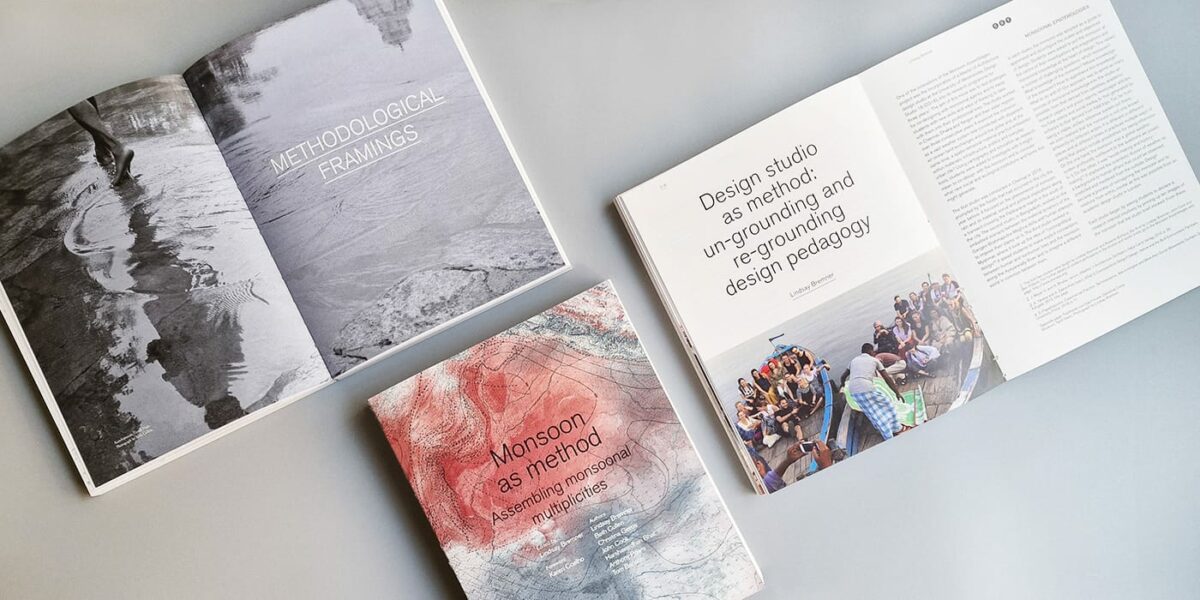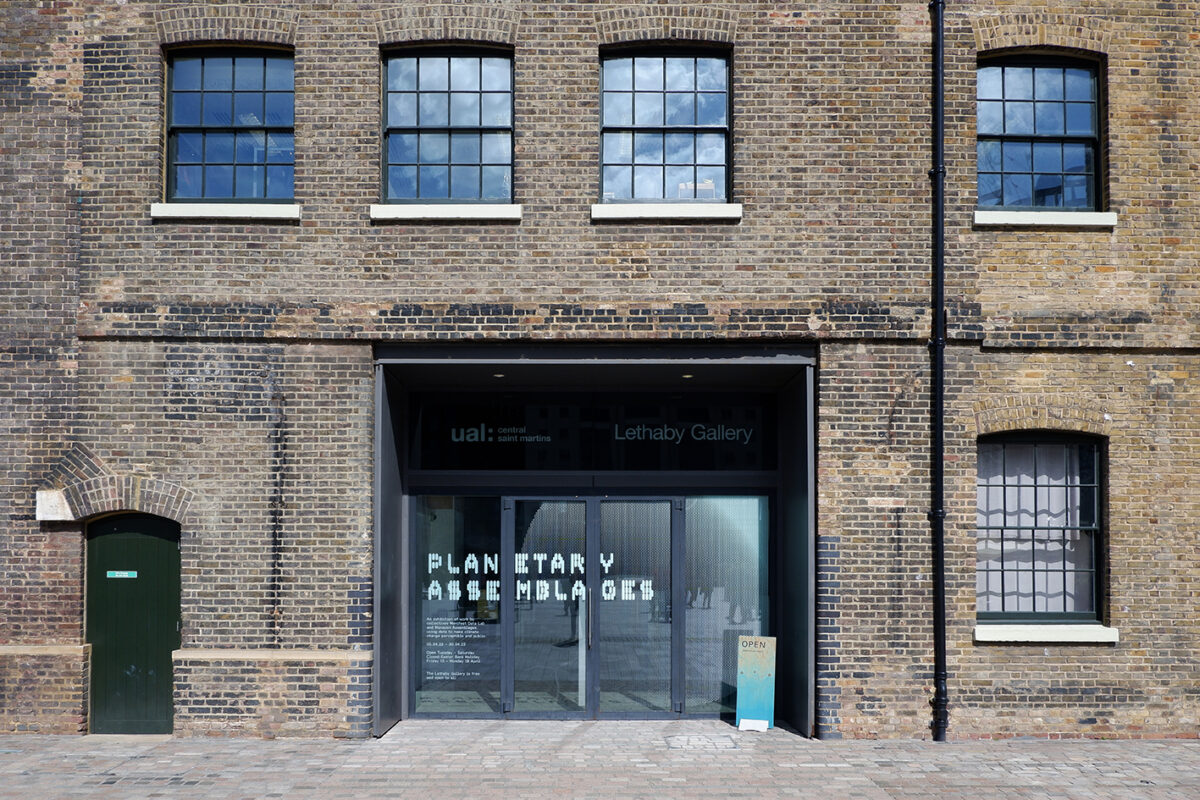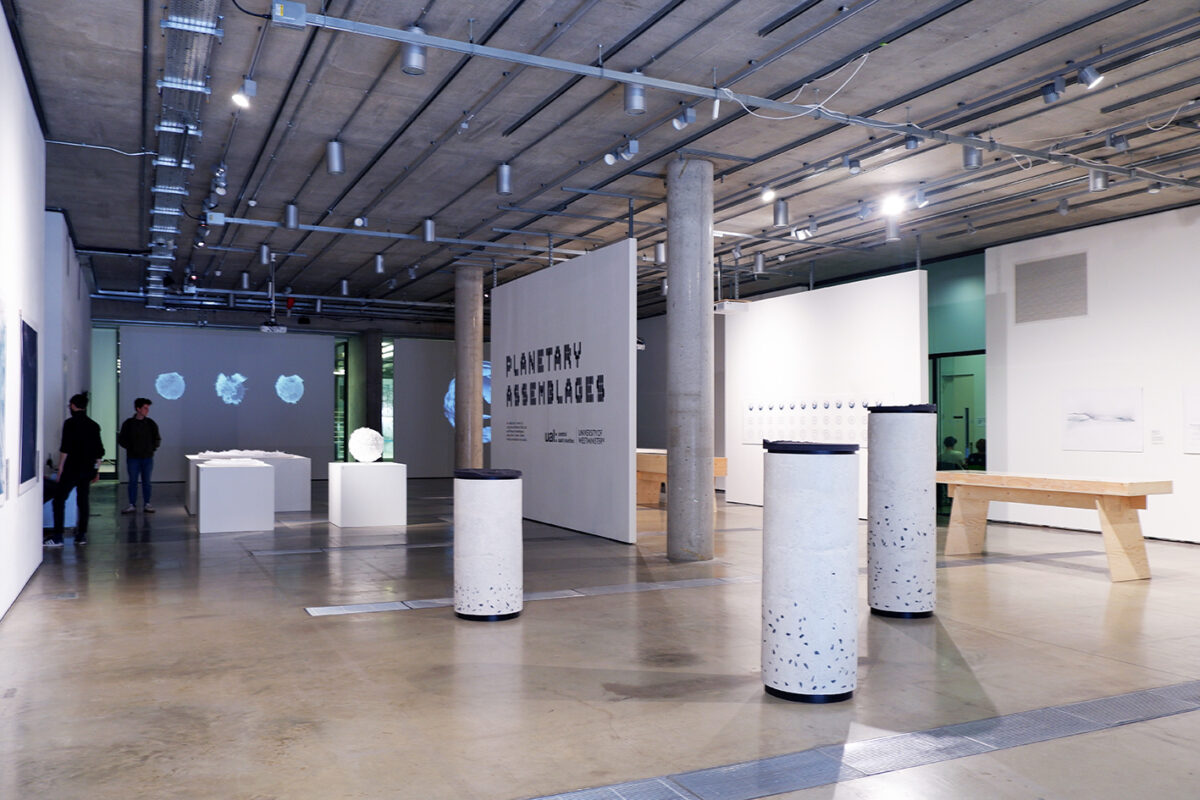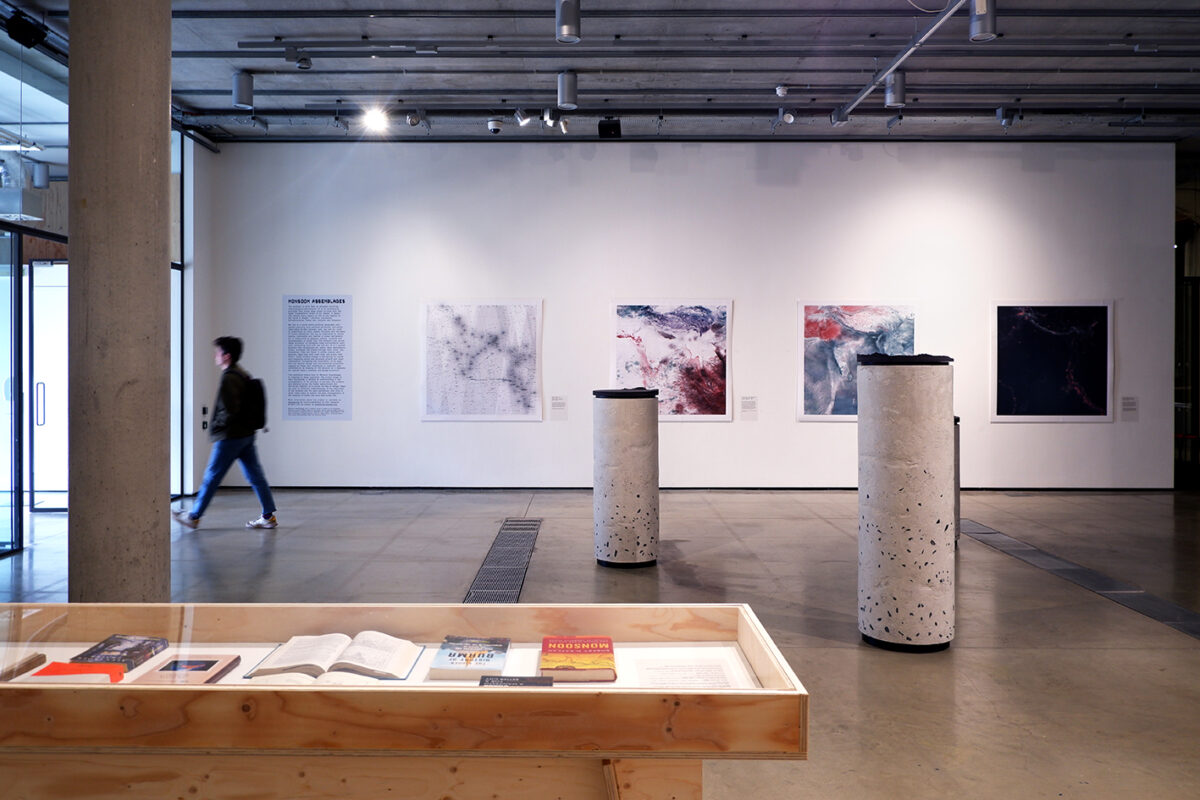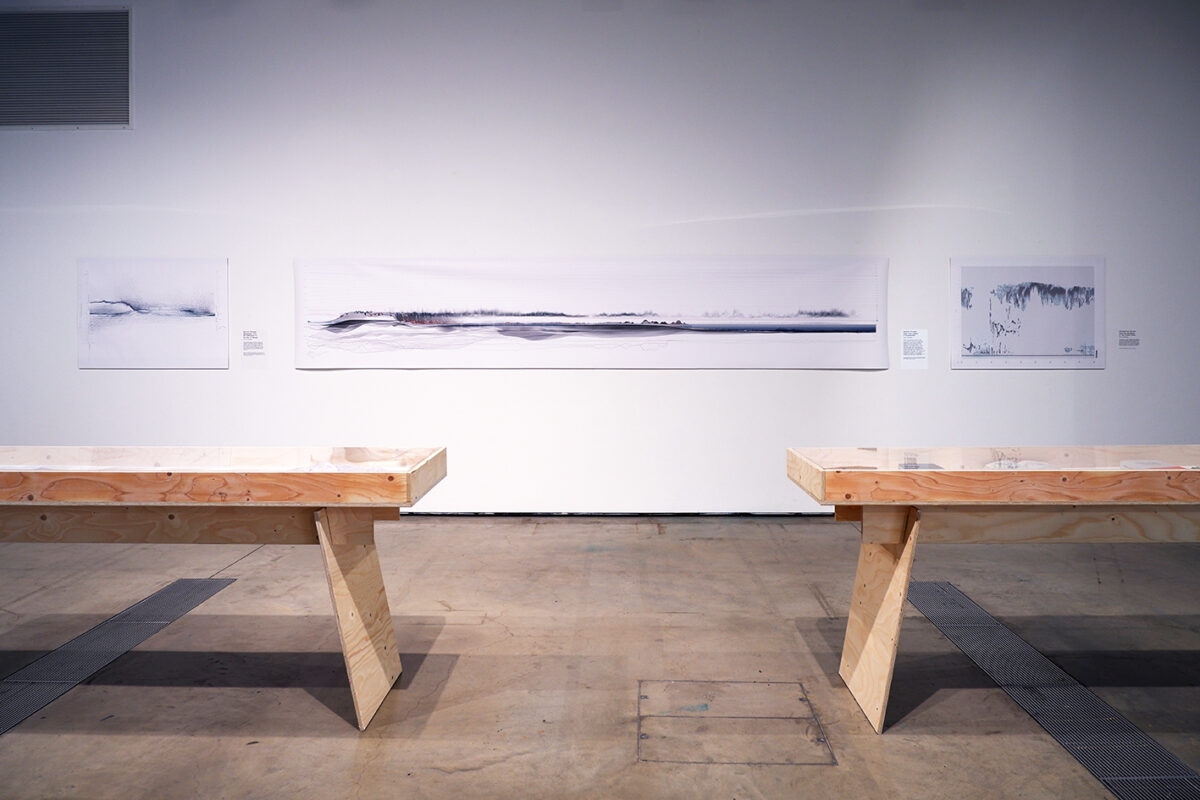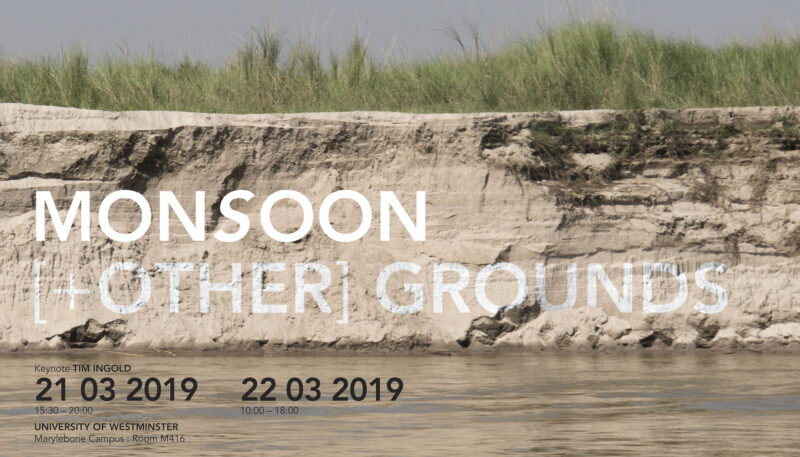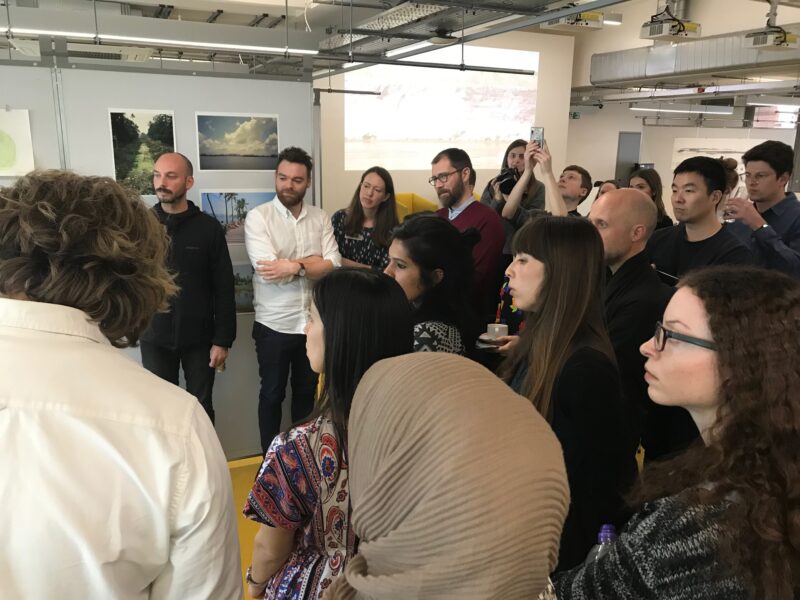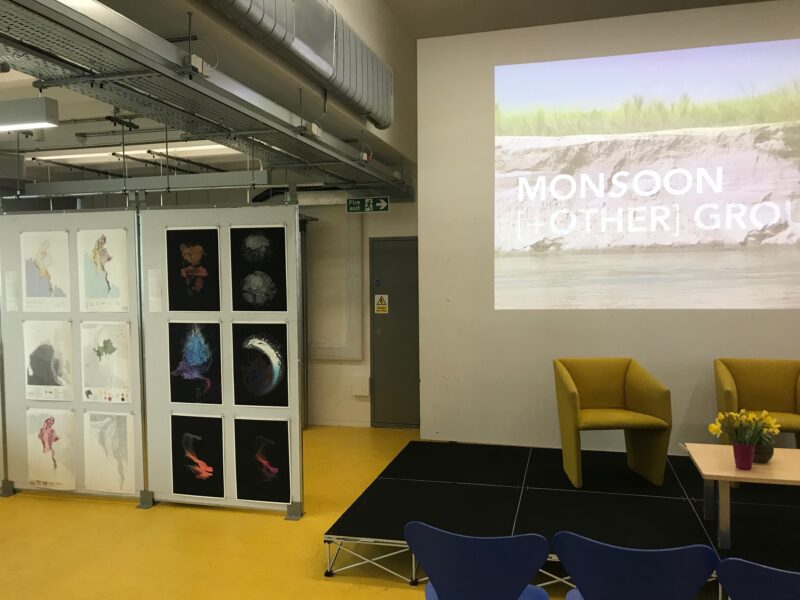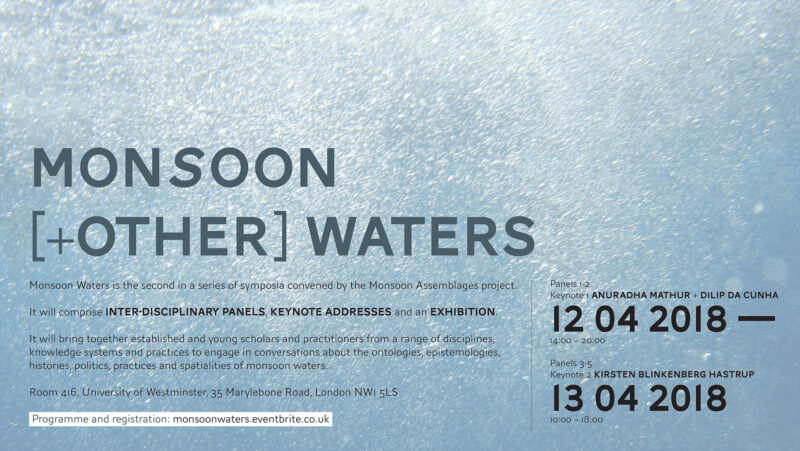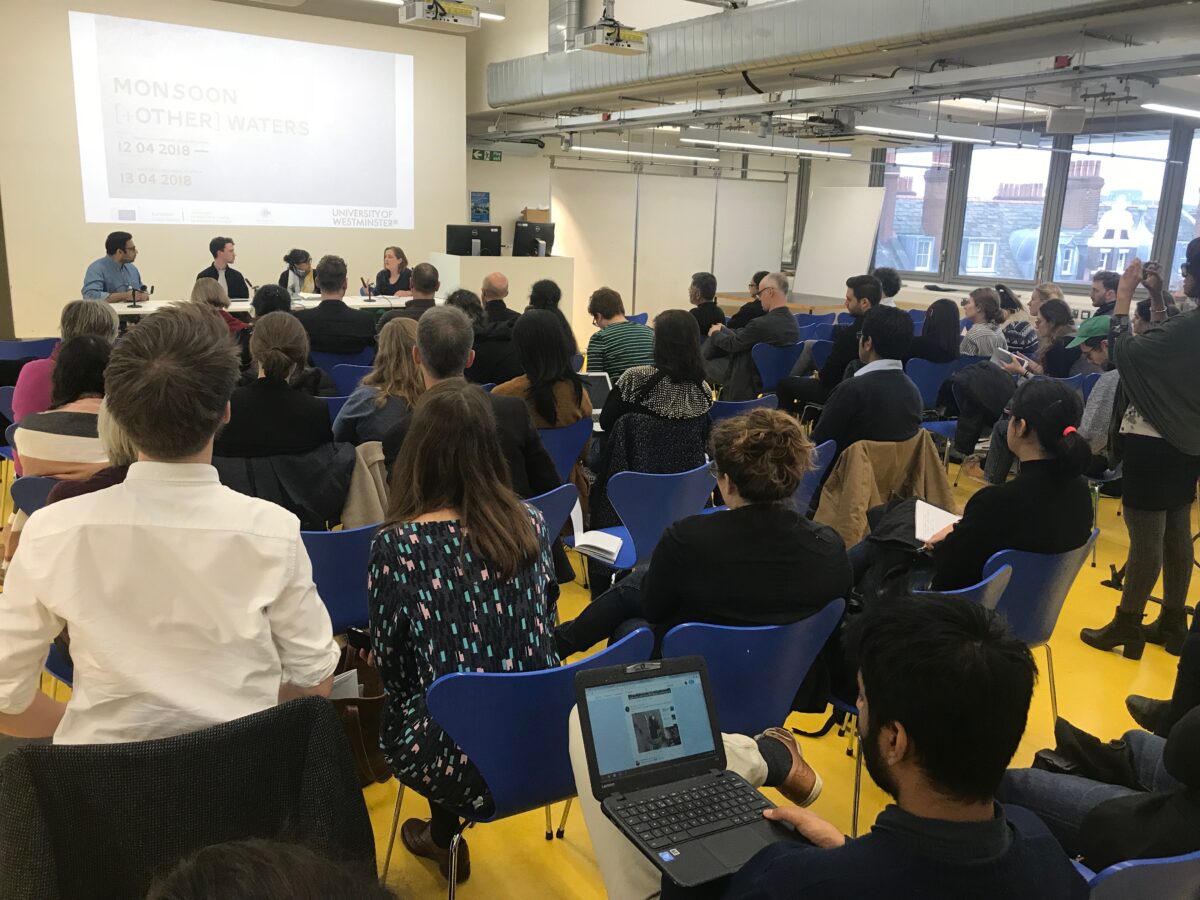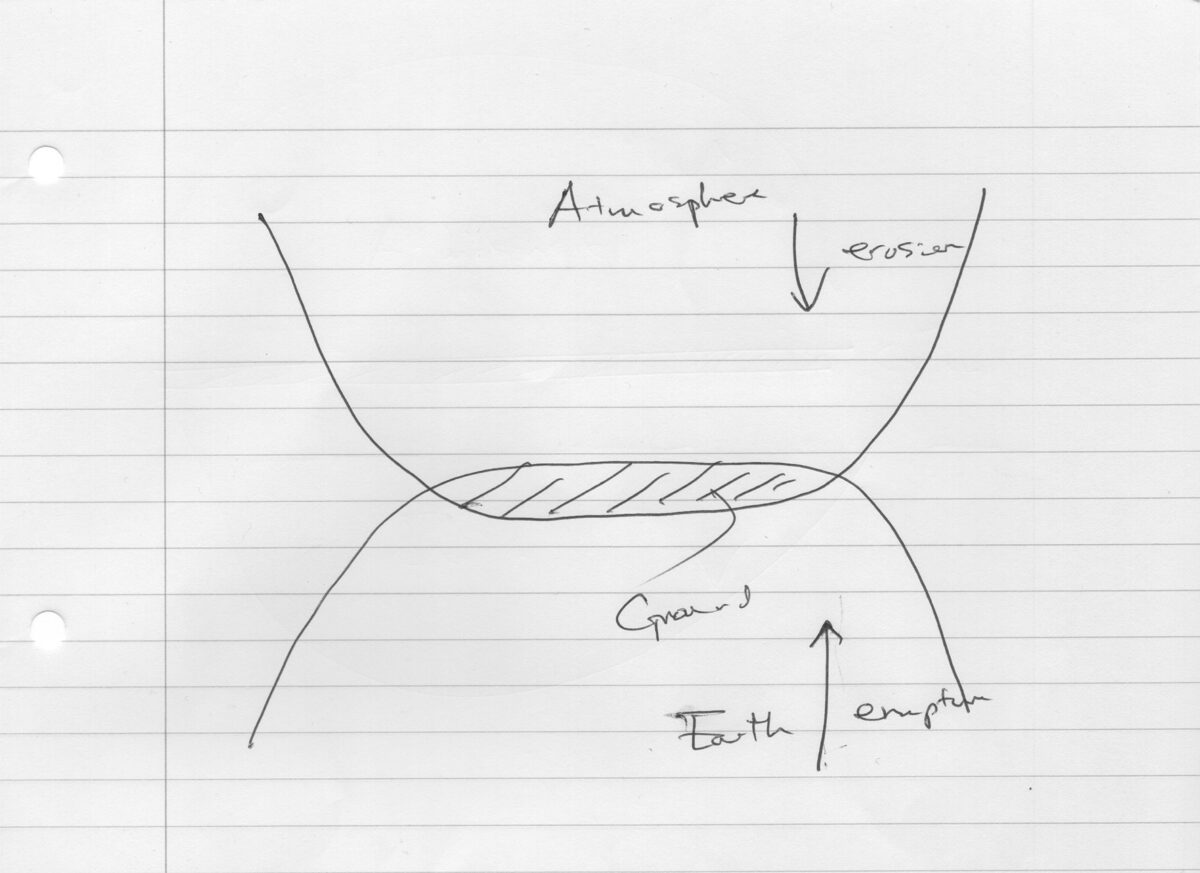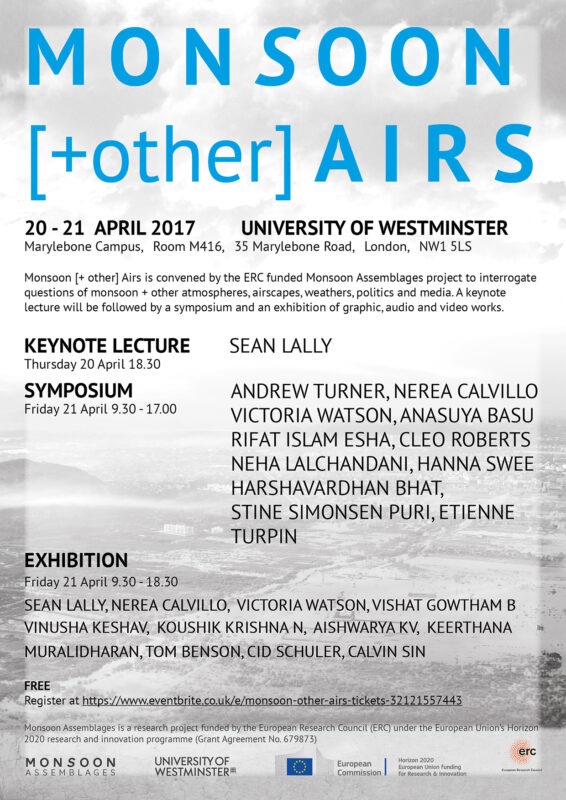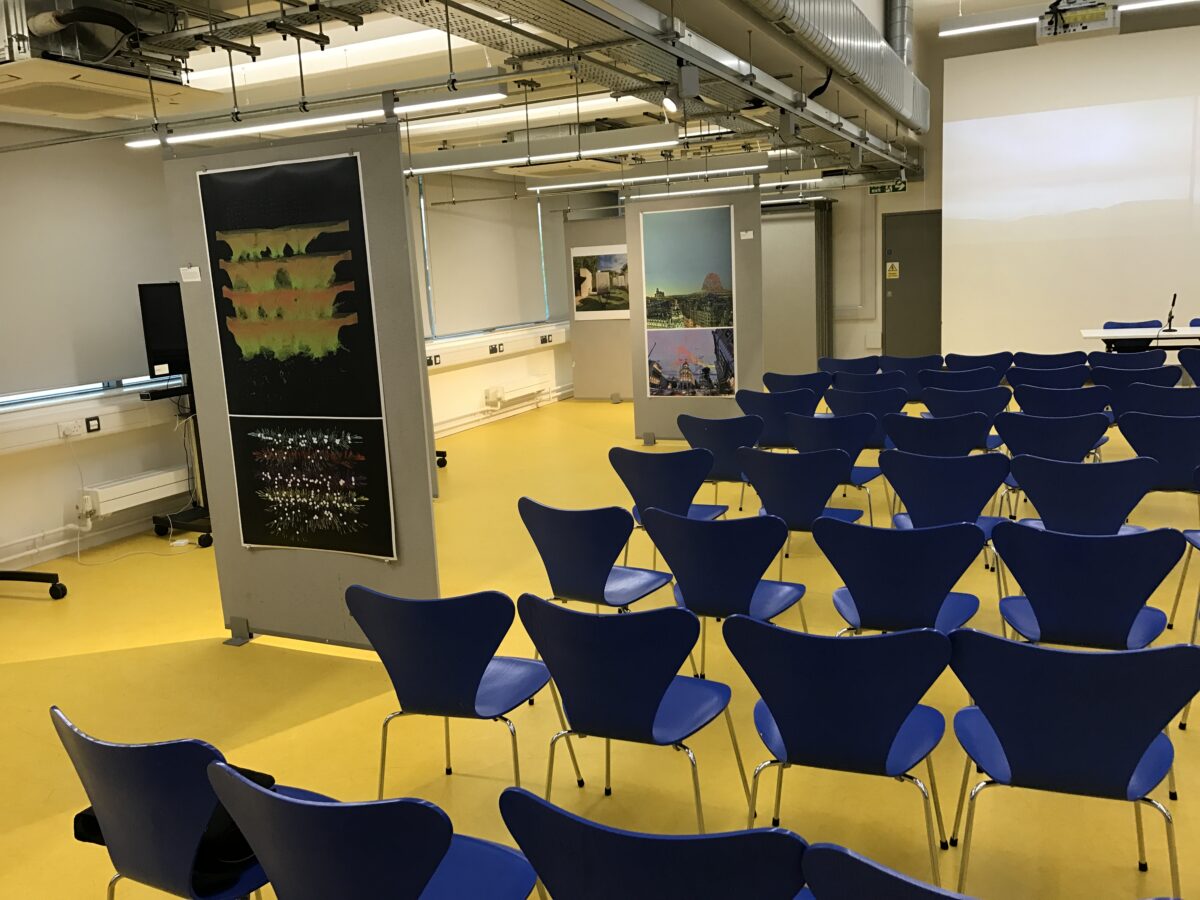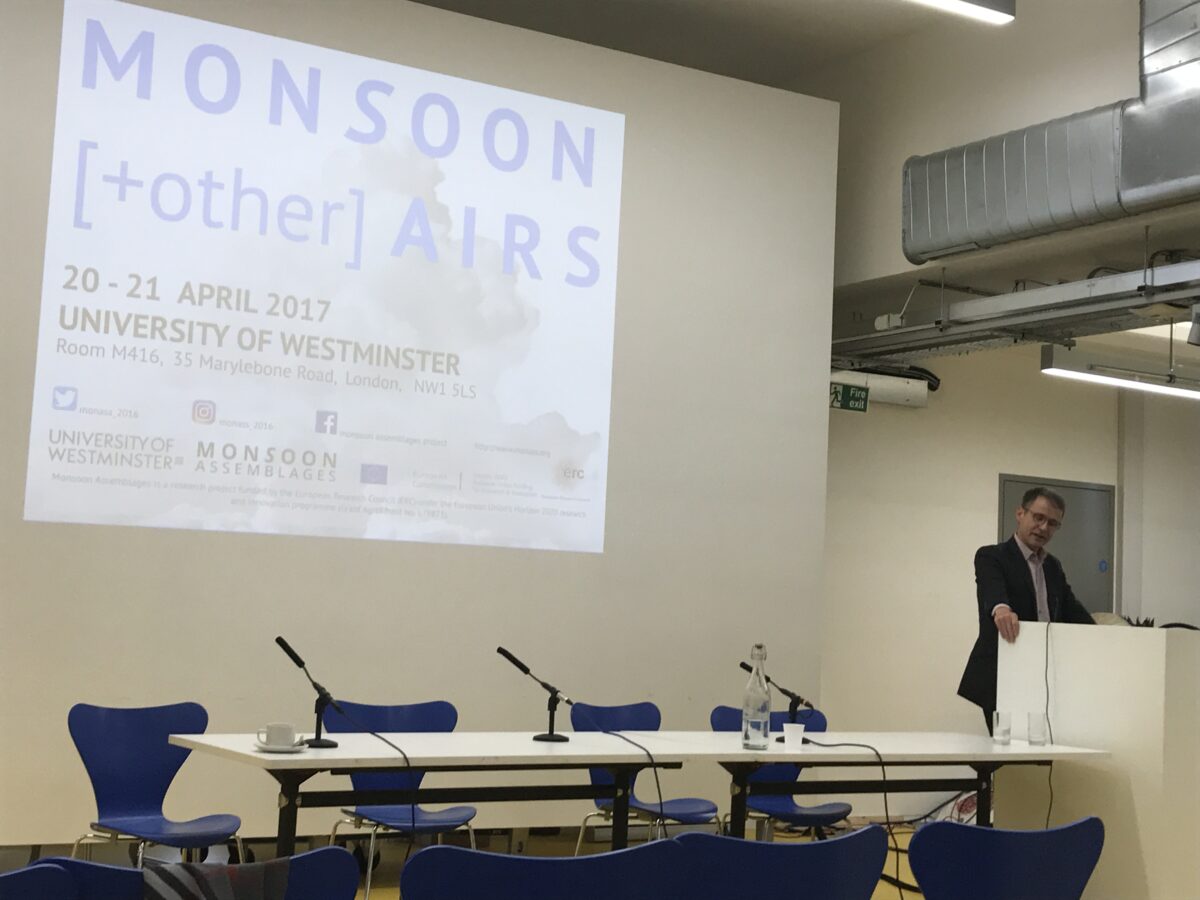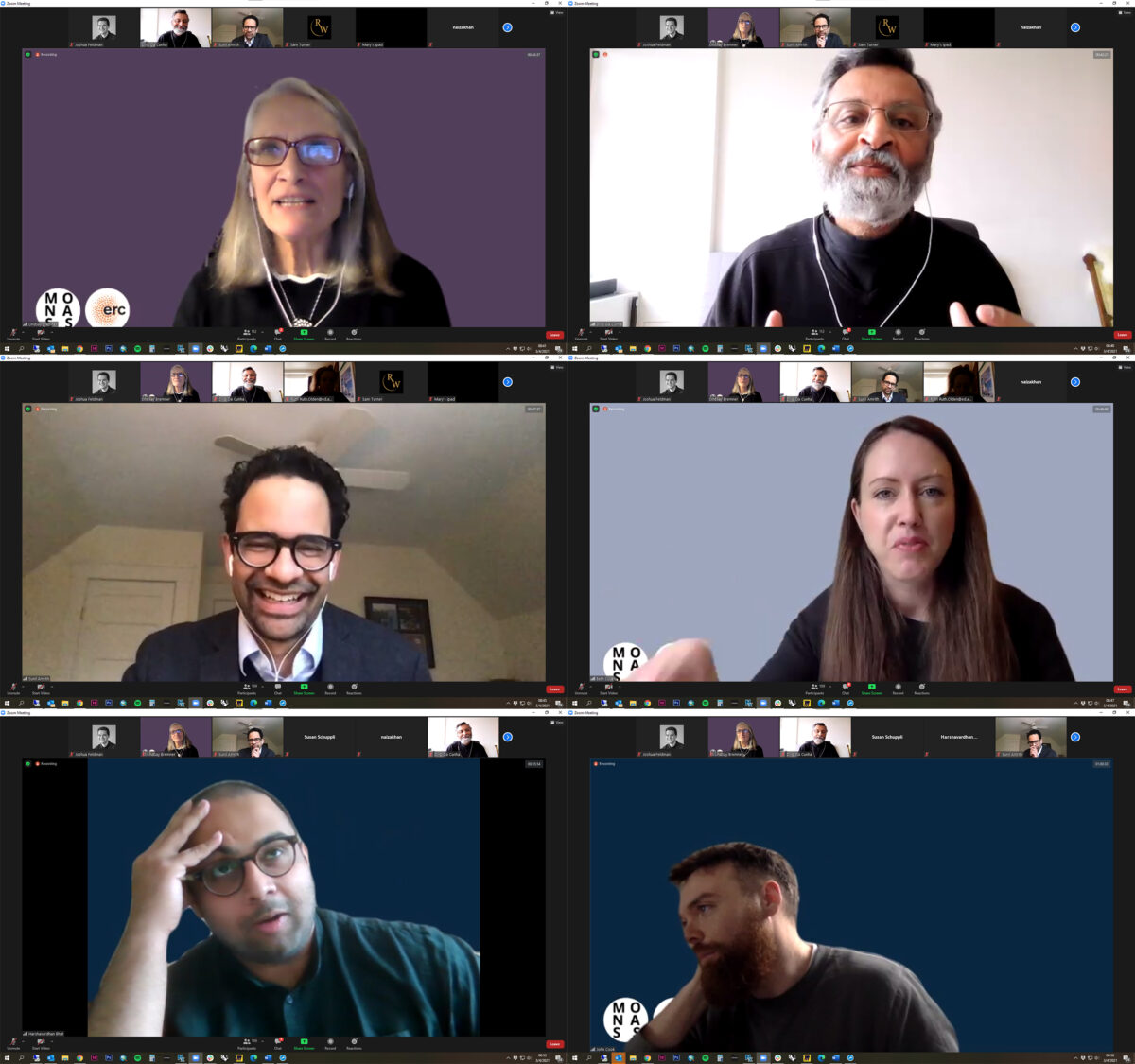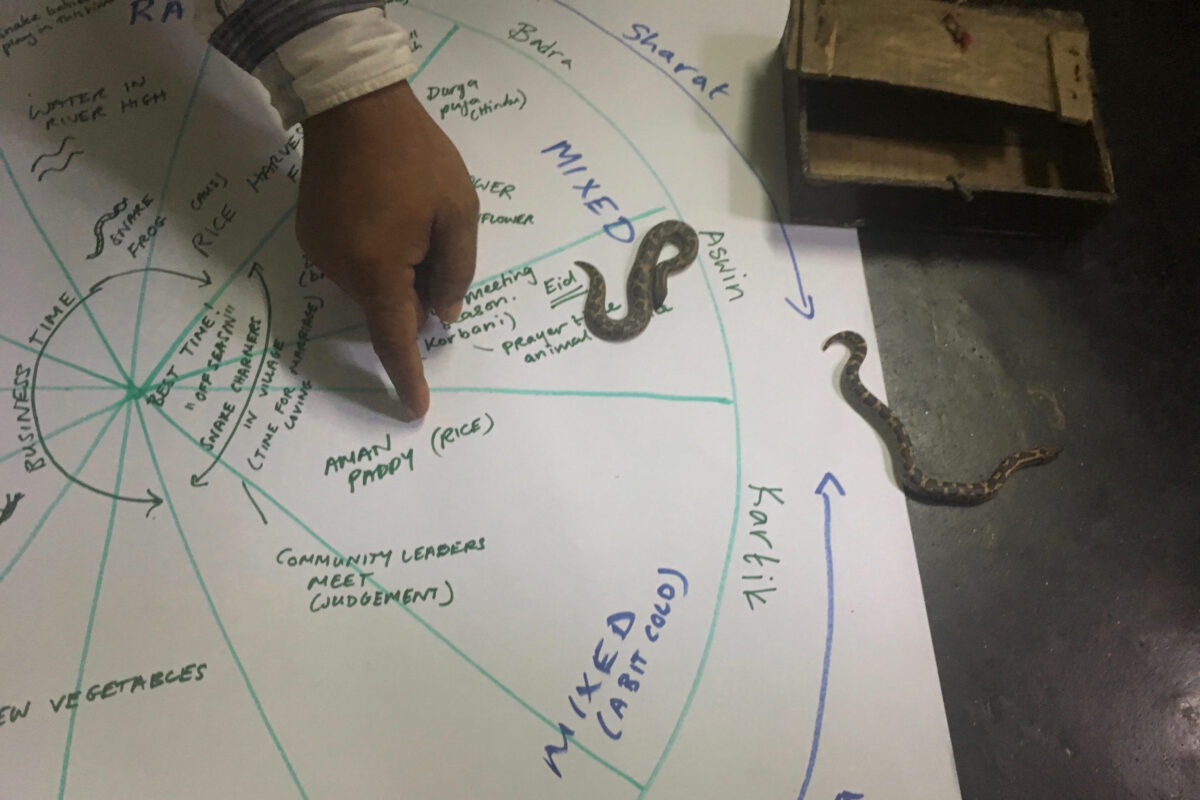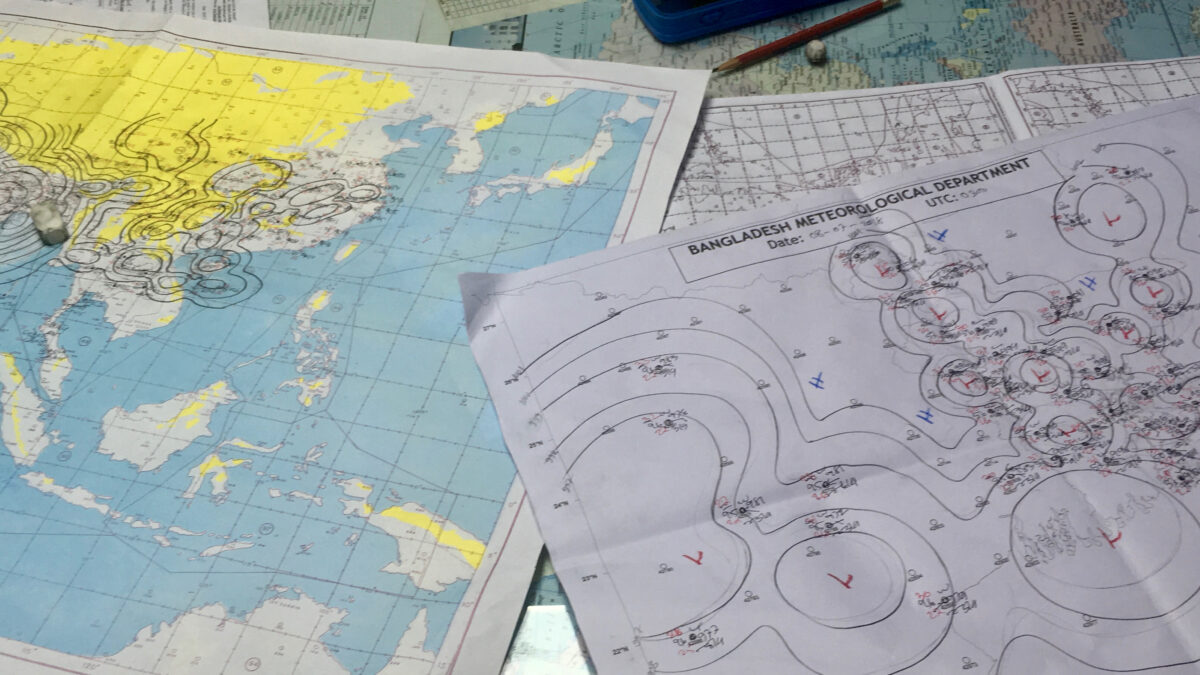The following is the Introduction to Monsoon as Method, Assembling Monsoonal Multiplicities, the edited volume by Monsoon Assemblages, published by Actar in 2022.
Introduction: Monsoon as Method
Lindsay Bremner
This is a book about a global weather system and our intra-actions with it over a five-year research period. It is a reflection on human relationships with the earth, with matter, with each other and with other species, within a volatile environmental system. At a time when the dominant image of the monsoon is of disrupted cycles and catastrophic events, the book is an invitation to think it differently. We invite readers to think it as what Anna Tsing calls an “open-ended gathering”, an assemblage of human and nonhuman ways of being, knowing and intra-acting across difference, a dynamic multiplicity whose story humans are part of, but by no means author. [1] We hope that the book provides a hospitable place for readers to intra-act with our monsoonal encounters and to find a position or trace a path for themselves within their complexity, knowing that any positionality will only ever be provisional and that tracks are circular and loop back on themselves.
In my grant application to the European Research Council for Monsoon Assemblages, I took issue with the discourse that pits society and climate as separate, bounded domains stacked up against one another. Quoting Bishop Desmond Tutu’s statement before the 2014 UN Climate Summit, “We fought apartheid. Now climate change is our global enemy”, I argued against the separation of climate from society that is deeply embedded within climate science and the popular imaginary. [2] This position is complicit with what Latour called the “modern constitution”, a knowledge system grounded in binaries and the assumption of objective access to a measureable, externalised world.[3] Countering this, postmodern theorists argued that, while there might be an external reality, human relations with it are constituted entirely through signs, language in particular, and that what is real, for humans, is language.[4] This foreclosed access to the material world except in the language of science, economics or culture (Foucault’s life, labour and language) through which external reality was brought into the realm of human intelligibility.[5] Within this epistemological framing, the discursive concept of climate was more real than the material world it described.
Monsoon as method is a concept and a methodology to trouble both of these epistemologies from within. Whilst science offers indispensable knowledge about the monsoon, it presents such knowledge as empirical facts about an externalised nature. Whilst postmodern theory enables critique of the monsoon as a societal practice, it cannot countenance the idea of the monsoon as a material actor whose actions have consequences for human and nonhuman life. Counter to this, Monsoon as method recognises the monsoon as not only an object of study and a discursive construct, but also a subject of world making, a “noteworthy actor” in the world, not in a positive, human-centric way, but as an elusive, active, inhuman other.[6] At times nurturing, at times recalcitrant, at times overwhelming, the monsoon follows logics that have little, if anything to do with what humans make of it, think of it or do with it. It is a restless, material multiplicity intra-acting with itself and the human and nonhuman bodies and practices that respond to and shape it from within in countless divergent ways. Monsoon as method is a way of thinking with the monsoon’s agential materiality and with its ongoing transformative power as it intra-acts with human and nonhuman bodies and practices. It eschews epistemology and political ecology for ontology, abstractions for material relations.
Monsoon
The monsoon is what Karen Barad called an “iterative process of spacetimemattering” across differences of humidity, pressure, temperature and salinity produced by intra-active energy exchanges between the sun and our spinning planet’s oceans, airs and continents. [7] It is one of the ways in which the Earth works out solutions to the interplay of forces that pass through it, including the pressures that humans are putting it under.[8] Deleuze and Guattari would call the monsoon a “multiplicity” or a “body without organs” – an atmospheric life of intensive, self-articulating difference, producing what we humans apprehend as wind, clouds, rain, weather fronts, storms, cyclones and so forth.[9] As it moves, the monsoon intra-acts with, rearranges and is rearranged by mountains and seas, soils and plants, human and nonhuman bodies and practices, engineered infrastructures, surfaces and spaces, by economics, politics, cultural rituals, everyday life and the technologies and media through which these relations are made manifest.
The word monsoon, from mausim in Arabic, meaning season, was originally used by sailors in the Arabian Sea to refer to the seasonal reversal of prevailing winds occurring at relatively fixed times each year that made the earliest transoceanic trading systems in the world possible.[10] This occurred, and still does, because the solar energy absorbed by land masses in the northern hemisphere in spring produces temperature differentials between land and sea, as the sea retains its winter cold for longer. Temperature differentials eventually grow large enough to trigger low level southwesterly winds that carry moist air from the Arabian Sea towards the west coast of India and from the Bay of Bengal towards Myanmar. The winds heat up and rise as they reach the coast and, forced upwards by the Western Ghats in India and the Arakan Yoma in Myanmar, the moisture in the air condenses out as rain. Latent heat released by the air as it rises in powerful upward air currents pulls in additional moisture, which maintains the rain as the monsoon progresses across the subcontinent pulled by the summer heat of the Tibetan Plateau. As winter approaches and the plateau cools, the winds turn and blow from the northeast towards southwest over the Bay of Bengal and the Arabian Sea. Over the sea, which is still warm, these cold winds mingle with convective air currents, frequently producing violent storms and cyclones.
This giant sea breeze system is relatively stable, but moderated by many factors including the timing and depth of snowfall in the Himalayas, the salinity of the Indian Ocean, the behaviour of the Indian Ocean Dipole (a coupled ocean atmospheric connection between the Indian and Atlantic Oceans) and human activity, such as the release of aerosols into the atmosphere. The most dominant of these variables is the El Niño Southern Oscillation (ENSO), the dynamic sea to air exchange that shifts periodically from west to east and back across the Pacific Ocean. Under normal conditions, northeasterly trade winds push warm surface water westwards across the Pacific Ocean towards the Philippines and the South China Sea, where they generate a gigantic pool of warm ocean and a low pressure zone in the air above it. Surface winds are pulled towards the low pressure zone and rise, transferring energy from ocean to atmosphere and forming, as geographer Mike Davis puts it, “a kind of cloud factory, where the warmest surface waters on the globe daily manufacture untold thousands of towering cumulonimbus clouds.”[11] At times, for reasons not yet fully understood, the warm water pool moves eastwards into the central Pacific. This produces the climatic disruptions around the globe that constitute El Niño e.g. storms in California and the west coast of South America, colder and drier conditions over central Canada, drought over West Africa and so on. In South Asia, El Niño frequently leads to weaker monsoons, such as in 2002 when the monsoon failed, resulting in the largest ever decline of rice production in Asia in recent history. As cold water returns to the central Pacific and the convection process returns to its normal position in the western Pacific, El Niño recedes. If this return overshoots, then a La Niña occurs, bringing dry conditions in the eastern Pacific and floods in the west, including excessive monsoon rains in Asia such as the floods in Pakistan and China in 2010.
This sketch of the monsoon is drawn from accounts put together by scientists on the basis of data accumulated from thousands of observation stations on land, in the ocean and in the atmosphere, and, more recently, using the mathematical representations of atmosphere-land-ice systems known as numerical climate models. But the monsoon is more than an annual meteorological cycle and abstract scientific data only partially account for it. For more than half the Earth’s human population and a large proportion of its nonhuman population too, the monsoon is a way of being, a matter of birth and growth, of life and death. It is registered by cultures, lifestyles, politics and economics that revolve around its cycles and are disrupted by its ways. It is embodied aesthetic, cultural ritual, fertile land, reproductive cycle, political clock and economic indicator. Cities in monsoonal regions are lively more-than-human ecologies that are shaped by the monsoon’s uncanny energies from within. They are seasonal, sometimes wet, sometimes dry places, darkened each year by towering rain-bearing cumulonimbus clouds driven by ferocious winds, inundated by torrential rains that seep, soak, spread, pool and flow and then evaporate and dry out, blurring boundaries between ground, water and air in continuous wet to dry, hot to hotter cycles. Such cities do not exist in relation to the monsoon, they are assembled within it. They cannot be climate-proofed against the monsoon and its vagaries (what an absurd idea!) for they are thrown together within it in intricate, knotted entanglements.
While mindful of the fact that the monsoon has its own modes of world making and is entirely indifferent to the questions we might ask of it or think or feel about it, Monsoon as Method is a mode of enquiry into ways the monsoon’s liveliness comes about, is lived, loved, feared and entangled in earthly substances, infrastructures, politics and multispecies lives. It is an approach to learning not about, but with the monsoon’s agential materiality – its cyclical temporality, its wetness and dryness, the humidity of its air, the heat build-up that precedes the arrival of the rains, its powerful winds and currents, its downpours and disruptions, its excesses and scarcities, its refusal to conform to expectations or predictions – and the intra-actions with other agential materialities, human and otherwise, with which it designs life-worlds.
Assemblages and multiplicities
Never is a plateau separable from the cows that populate it, which are also the clouds in the sky.[12]
Monsoon as Method is premised on Deleuze and Guattari’s concept of the assemblage.[13] The English word assemblage is a translation of the French word agencement, which means an arrangement, layout or fitting together of parts. Deleuze and Guattari used this notion to challenge empirical assumptions that reality is made up of discrete, individuated, measureable, law-abiding entities, and to theorise it as an interminable becoming of promiscuous, entangled, intra-acting intensities. Assemblages are multiplicities, complex ensembles generated solely out of the forces at work within them with no reference to a transcendent unity or set of co-ordinates.[14]
Multiplicity, which replaces the one no less than the multiple, is the true substantive, substance itself. … Even the many is a multiplicity; even the one is a multiplicity. … Everywhere the differences between multiplicities and the differences within multiplicities replace schematic and crude oppositions. … Instead of the enormous opposition between the one and the many, there is only the variety of multiplicity – in other words, difference.[15]
Within an assemblage, a haecceity (a term Deleuze and Guattari borrowed from medieval scholastic philosophy meaning an object with unique, individual properties or an identity) “has neither beginning nor end, origin nor destination; it is always in the middle. It is not made of points, only of lines”.[16] Assemblages, multiplicities, while they might appear to individuate or congeal into coherence or unity for a time, are always provisional; they are processes of perpetual becoming brought about the intra-actions between their constituent parts, themselves also multiplicities: “there are only multiplicities of multiplicities forming a single assemblage” extending to the entire Universe.[17] Thinking the monsoon through the notion of assemblage overcame thinking of it as a discrete unit of meteorological space-time and transformed it into a multiplicity of interpenetrating, intra-acting ways of being, knowing and doing, some of which are human, most of which are nonhuman, some of which are vastly distributed in space and time, others of which are proximate. While the monsoon might congeal into something recognisable for a time, such as a cloud or a downpour or an onset date, the complexity of the intra-actions at play within it ensure that “becoming other than itself” is all that one can be sure about it.[18]
These ideas resonate with Jane Bennett’s use of the concept of assemblage to theorise the relations obtaining between the parts of the volatile but functioning whole of globalisation. Bennett argued that globalisation was an “ad-hoc grouping of diverse elements … able to function despite the persistent presence of energies that confound it from within”.[19] It was not governed by any authority and, while its components worked together, their co-ordination never rose to a level of unity, for “energies and factions fly out from it and disturb it from within.”[20] This understanding of how assemblages are structured was informed by Bennett’s analysis of electrical power grids, which, she found, included some very active and powerful nonhumans – electrons, trees, wind, fire, electromagnetic fields, and, had she been in South Asia, no doubt monsoonal agency would have played its part, alongside humans and their discursive constructions. A less electrical, more ecological understanding of assemblage was developed by anthropologist Anna Tsing, who followed the lead of ecologists in turning to the idea of ecological assemblages to overcome the fixed and bounded notion of ecological communities. [21] Tsing’s assemblages are not closed communities, but open-ended gatherings of life-ways held together by intentional and unintentional encounters.These encounters might comprise eating one another, competing with one another, helping one another out, or just living alongside one another. Assemblages gather discrepant ways of being across and despite difference without the precondition of unity. Rather than closing questions of how the various species in an ecological setting relate to one other, they are “tools for exploring the constitutive dynamics of landscapes”. [22] In our work, assemblage became a tool for exploring the dynamics of monsoonal urbanities as multiple and lively human and more-than-human ecologies, in which technologies, materials and various life forms assembled in concrete, irreducible, emergent ways.[23]
The concept of assemblage enabled us to distance our work from British historian Rhoads Murphey’s construct of “Monsoon Asia,” which he took from fellow historian C.R. Boxer and used to define a “unit of study” of Asia.[24] Murphey’s Monsoon Asia was a more or less rigid container defined by geographic boundaries in which rainfall had produced population densities and cultures with common features. But, going with Deleuze and Guattari, unities are deceptions, designed to obscure rather than reveal the nature of reality.[25] Along with other geographical units such as the Middle East or Sub-Saharan Africa, Monsoon Asia is a remnant of a European epistemological spatial structure that organises knowledge of the world in rigid categories as they appear from the colonial centre, reinforcing fantasies of otherness, power and dominance.[26] The monsoon in Monsoon as Method is not a signifier of otherness, but of a multi-positional method that moves from outside to inside, pushes the global positionality of science up against the situated knowledge of everyday experience and changes the monsoon itself from being an object of study into a forceful subject of world making.
How matter comes to matter
Karen Barad was instrumental in shifting our conception of the monsoon from a thing or an idea to the life-world in which our research practice took shape. She argued that western culture and knowledge practices have been premised since Democritus on the separation of the ontologically disjointed domains of words with inherent meanings on one side and things with inherent properties on the other; of humans, and only certain humans, who do the thinking and the representing versus everything else.[27] Barad rejected this representationalist metaphysics and everything that goes along with it. She replaced it with what she called a “performative metaphysics”, in which matter comes to matter through intra-actions between material-discursive components (or what she calls the relata) of phenomena.[28] “Reality is not composed of things-in-themselves”, she wrote, “but of things-in-phenomena.” [29]
The primary ontological units are not things but phenomena – dynamic topological reconfigurations / entanglements / relationalities / rearticulations. And the primary semantic units are not words but material-discursive practices through which boundaries are constructed within phenomena.[30]
Barad invented the word “intra-action”, as opposed to interaction, to capture what takes place in phenomena. [31] Interaction, like hybridity, she argued, assumes that there are separate individual agencies that precede their interaction. Intra-action on the other hand suggests that the components of phenomena do not pre-exist their relations, but emerge through intra-actions within phenomena.[32] Intra-action, in other words, is the mutual constitution of entangled agencies, or what Barad refered to as the “iterative becoming of spacetimemattering”.[33]
Within the entangled intra-actions of phenomena, components become differentiated and intelligible to one another through the enactment of what Barad called “agential cuts”. [34] Agential cuts are material-discursive practices that emerge through intra-action to determine the boundaries and properties of components of a phenomena and to make particular embodied concepts meaningful. Barad made it clear that agential cuts are not imposed from without, they emerge through intra-action, and they are not only the remit of humans: “discursive practices are not placeholders for human concepts, but are specific material articulations of the world”.[35] In fact, human concepts and practices are not foundational to the nature of phenomena at all. Here I am reminded of Merlin Sheldrake’s observations of how truffle fungi interpret their environments by sensing the chemical emissions of the organisms around them and arranging and rearranging their own in response. [36] In this way they negotiate complex interchanges with tree roots, extract nutrients from soils, procreate, hunt, fend off attackers and offer themselves up to be devoured.[37] While they might not be conscious or articulate in a human sense, truffles use a chemical vocabulary to give meaning to their world and to enact iterative changes to ensure their survival. Chemistry is their agential cut. Vicky Kirby proposed that the earth’s materiality is “actively literate, numerate and inventive as anything we might include within Culture.”[38] This claim suggested that the Earth, in its materiality, thinks, articulates and self differentiates. To refer to Sheldrake on fungi again – “mycelium is a living, growing, opportunistic investigation – speculation in bodily form”.[39] Matter is alive and intelligent, not because we humans bestow intelligence on it, but because of the material-discursive intra-actions through which it engages with its surroundings. Tim Ingold put it like this:
Things are alive and active not because they are possessed of spirit – whether in or of matter – but because the substances they comprise continue to be swept up in circulations of the surrounding media that alternately portend their dissolution or … ensure their regeneration. [40]
Matter is not inert substance, but material-discursive intra-action all the way down. “The world is an ongoing open process of mattering, through which mattering itself acquires meaning and form in the realisation of different agential possibilities”.[41] In attributing this kind of liveliness to matter and material intelligence to the world, nouns become verbs – matter matters, hills hill, aerosols aerosol, walls wall, monsoons monsoon, and it is only through hilling that hills are hills and monsoons are monsoons etc. It also means that there is no such thing as research, only researching, through material-discursive intra-actions within the reverberating verbings of the world, through which agential cuts emerge to make the world provisionally intelligible. In other words, epistemology is inseparable from ontology, knowing from being and doing. Barad reminded us that separations are a consequence of a representationalist metaphysics that assumes an inherent difference between human and nonhuman, subject and object, mind and body, matter and discourse. [42] She replaced representationalism with onto-epistem-ology – the study of practices of knowing-in-being as a better way for understanding the world in its emergent becoming. Deleuze and Guattari referred to this as thinking “not from the root up, but rather only from somewhere about the middle”.[43]
Anthropologist Hannah Knox’s recent book Thinking Like a Climate is an account of what it means to think from the middle. The book is an ethnography of how the material dynamics of climate change were translated into the work of governing the city of Manchester in England over a ten year period.[44] The book is also a reflection on how climate change began to weather the foundations of Knox’s own research practice. In the process of researching climate change, she realised that she could no longer document and describe it from the outside, for climate change was not a condition from which she could extract herself. “In a climate-changed world”, she wrote, “anthropology had no special privilege to remain the same. Our representations and our practices too will have to move with the carbon, the weather, and the computer models that carry them into the practices of human world making and mould them into parts of the cultural imagination.”[45] Climate change became a “contact zone of practices and ideas” in which anthropological reflections sat alongside and intra-acted with other epistemologies and practices.[46] Her own visceral, embodied encounters with climate change also began to trouble her reliance on air travel. She made the decision to embark on an experiment of doing anthropology without flying, and put the anthropological questions that air travel posed at the centre of her endeavours. Practices of being and knowing, of matter and discourse, of ontology and epistemology were mutually implicated.
Weathering
As a practice of knowing-in-being and in keeping with the idea that intra-activity transforms nouns into verbs, Astrida Neimanis, Rachel Loewen Walker and Jennifer Mae Hamilton developed the idea of weathering, as opposed to weather, as a “critical response concept and practice for our time”.[47] The concept of weathering drew on an earlier idea of trans-corporeality developed by Tracy Alaimo to describe relations between bodies and their environments as intra-active material exchanges.[48] Trans-corporeality dissolved the figure ground relation (an image familiar to architects) between bodies and their environments, proposing that “all creatures, as embodied beings, are intermeshed with the dynamic material world, which crosses through them, transforms them and is transformed by them”.[49] Neimanis and Walker’s weathering was a trans-corporeal frame to imagine bodies, human and otherwise, as implicated in climate change. Our bodies, Neimanis and Walker wrote, are “weather-bodies … thick with climatic interactions … makers of climate time”.[50] What they meant by this was that “the ebb and flow of meteorological energy transists through us, just as the actions, matters and meanings of our own bodies return to the weather in a myriad of ways”.[51] Climate and weather are not backgrounds to our lives, but time that we make together, just as we are made by the time makers all around us – the earth’s rocks and soils, decaying buildings, polluting smoke stacks.[52] This proposition countered linear narratives of climate change encapsulated in graphs and statistics and exposed the futility of the idea that humans can somehow slow it down or fix it as if we were not fully implicated within it. It engendered possibilities for responsibly imagining and intervening otherwise in the climatic entanglements of which human bodies are a part. Given that weathering is neither metaphor nor analogy, but a material-discursive practice, it enabled Neimanis and Hamilton to think about the ethics of exposure to weather in relation to the political economies of place. For, while all bodies weather, “not all bodies weather the same – weathering is a situated phenomena embedded in social and political worlds”.[53] In other words, weathering, or “learning to live with the changing conditions of rainfall, drought, heat, thaw and storm” is “never separable from the ‘total climate’ of the social, political and cultural existence of bodies”.[54]
Monsoon as method
Perhaps our hopes for accountability, for politics, for ecofeminism, turn on revisioning the world as coding trickster with whom we must learn to converse.[55]
Monsoon as Method is a way of thinking with the monsoon to make urban worlds intelligible within the conceptual framings sketched out above. It focuses on the intra-active material agency of the monsoon in the formation of urban bodies, politics, culture and sociability. It is not a theory about the materiality of the monsoon, but rather a recognition that the monsoon is “agential – it acts, and those actions have consequences for the earth and human and nonhuman lives”. [56] Just as Amitav Gosh understood that land is demonstrably alive, “that it does not exist solely, or incidentally, as a stage for the enactment of human history; that it is itself a protagonist”, so we understood the monsoon to be a protagonist in urban life.[57] Nigel Clark and Bronislaw Szerszynski argued that because that the Earth is materially closed, but energetically open, it is “self-incompatible, always out of step with itself” and constantly figuring out ways to live with itself.[58] As one of the ways the Earth lives with itself, the monsoon has a very simple ambition – to resolve the tensions that arise from the interplay of forces set up by the revolution of the Earth around the sun and the dissipation of solar energy. Monsoonal circulations, convections, winds, currents, storms and so forth are partial solutions to the interplay of these forces. In never quite solving Earth problems, they exert agency and transformative power within the complexity of the material, discursive, human, more-than-human, corporeal and technological relations that make up urban worlds. Monsoon as Method offers a methodology for understanding the significance and consequence of the agential power of monsoonal dynamics within urban life and urban life within it. It responds to Elizabeth Grosz’s call to think through rather than about the Earth, and what it means to afford political power to “the elemental forcefulness of the Earth itself”.[59]
Monsoon as Method was developed between 2016 and 2021 by a small interdisciplinary team of researchers – myself, an architect; Dr Beth Cullen, an anthropologist; Christina Geros, a landscape architect; John Cook, an architect, and doctoral researchers Anthony Powis, an architect, and Harshavardhan Bhat, a political scientist, in the School of Architecture and Cities at the University of Westminster in London, supported by a European Research Council (ERC) grant. ERC grants are extraordinary – they encourage novel research questions, favour interdisciplinary research teams, support untested methodologies and expect that research produce unanticipated outcomes. Applying for an ERC grant is a rigorous procedure, but once awarded, what one does with it is flexible and lightly monitored. While requiring that grant agreements are honoured, the ERC accepts that research objectives and methods might diverge from those originally proposed and allows one to amend agreements and move budgets around as research priorities change. These characteristics make ERC grants unique within the current neoliberal, impact driven research funding landscape. Without the flexibility and openendedness of the Monsoon Assemblages ERC grant, Monsoon as Method would never have seen the light of day.
What are we talking about when we talk about the weather? We are talking about the rain, the clouds, the air, the breath, the fog, the gas, the dust, the soil, the carbon, the climate, the bomb, the border, the math, the sensor, the sensorium, the satellite, the snow, the ice, the exorcist, the shaman, the gods, the future, the good fortune, the bad luck, and the better times ahead.[60]
Our guide in developing Monsoon as Method was to stay with what the monsoon pointed out to us. Yet what was the monsoon? Which monsoon were we talking about when we talked about the monsoon? Was it the monsoon described in the work of atmospheric and earth scientists, or was it the torrential rain that soaked us through in Yangon? Or was it both? How was knowledge about it generated? Was the monsoon generated through data and climate modeling the same monsoon that replenished the ground water in Chennai, or turned Bangladesh into a watery terrain each year? Was what we called the monsoon an imperial material-discursive construct that had little to do with how people in the places we were studying experienced or understood their weather-worlds?
Our approach to these questions was informed by Donna Haraway’s proposition that all knowledge is partial and comes from somewhere, that knowledge is situated. [61] Situated knowledge is not necessarily immediate or embodied, but rather acknowledges and names where and where not it is generated from in mental and physical space, as an act of political and epistemological responsibility.[62] In our project, research evolved through iterative circulations between our workplace in London and field sites in South and Southeast Asia; between engaging with the monsoon remotely and engaging with it and monsoonal phenomena directly through embodied experience. It was through the multi-sitedness and iterativity of this research practice that our ideas and methods developed. As western researchers, we were acutely aware of the history of research as a colonial encounter and of the extractive legacies and violence of the western eye. Linda Tuhiwai Smith reminded us that research is “one of the ways in which the underlying code of imperialism and colonialism is both regulated and realised”. [63] Western science is operationalised by turning places into field sites and people into objects of study. Transmogrified in this way, colonised subjects are appropriated as raw material for knowledge production, denied any agency in the research process and their own forms of situated knowledge either appropriated or rendered irrelevant. The practice of situated knowledge production constructs its objects of knowledge differently, not as resources, but as actors and agents in intra-active processes of knowledge production. Situated knowledge production acknowledges that knowledge claims are claims on people’s lives and on the life of the Earth and views positions of subject-hood and object-hood as reversible.
In our work place in London, we began our research process by developing a provisional understanding of the monsoon. We immersed ourselves in scientific literature from fields as diverse as atmospheric science, geology, history, politics and urban studies, practicing what Clark and Szerszynski call “interdisciplinary interloping”. [64] We visited historic archives and libraries; we scoped out cities and field sites; we developed collaborative partnerships and planned field work. We started a reading group to read, talk and think through the theoretical questions our work raised. We hosted and contributed to symposia to engage in dialogue with other scholars from a range of disciplinary backgrounds.[65] We taught an architecture design studio to test ways that design might be transformed if ideas of monsoonal agency activate design processes. We developed techniques to translate atmospheric data into maps that visualised monsoonal mattering at a range of scales. Our thinking began to take shape around certain key authors, key texts and key words: assemblage, multiplicity, matter, weathering, weather-world, weather-ways. We printed these out and pinned them to our office wall as a way of building a common framework from which we could work individually and collectively.
We structured our field visits as short, multi-sited, iterative engagements at different times of the year with the cities we were studying – Chennai, Dhaka, Yangon – and, for Harshavardhan Bhat, Delhi. However, while monsoonal agency coursed through these cities, it soon became evident that we needed to comprehend far wider monsoonal geographies to understand urban monsoons. While mapping climate data played an important part in this endeavour, so did embodied visits to Bagan, Chandpur, Kanyakumari, Leh, Mandalay, Sylhet and other cities and towns in neighbouring regions. We travelled, walked, breathed, listened, looked, smelled, touched, ate. We engaged in informal and structured conversations and conducted interviews with activists, citizens, city officials, meteorologists and social scientists. We were supported by collaborations with research organisations and academic institutions. We used calendars and maps as participatory research tools. We undertook ethnographic sketches of infrastructures, material substances and nonhuman species. We captured our impressions in field notes, photographs, sound recordings and videos.
Once back in London, we reflected, analysed, edited, mapped and archived this material. Fields spoke back, causing us to modify or change our research plans. After field work in Chennai that had taken place within the city’s limits, we realised that how weather was produced and experienced in each city could only be understood if each city was analysed as part of wider meteorological and territorial systems and, at the same time, at scales far smaller and more material than those suggested by the concept of city. We also began to explore historical encounters with place, not as historians, but in order to understand the extent to which monsoonal forces had affected the siting of cities and how they grew. For five years, we thought, read, talked, walked, ate, dreamt, and slept the monsoon. It seeped onto our bodies and changed not only how we did research, but who we were and how we saw and intra-acted with the world. Eventually, through brainstorming sessions and research meetings, scouring over maps at different scales, using notes, trace-paper, post-it notes, doodles, keywords and bullet points we realised that what our research practice had done was to inaugurate an array of “other-worldy conversations” with the monsoon, in which a range of subjects – human, nonhuman, infrastructural and material – had participated, not as objects of study, but as intra-locuting subjects between ourselves and monsoonal weather worlds.[66] Monsoon as Method emerged as a form of intra-locutionary research practice aimed at “partial, locatable, critical knowledge, sustaining the possibility of webs of connections called solidarity in politics and shared conversations in epistemology”.[67]
While interlocution is an interchange of speech or a conversation between responding, autonomous agents, intra-locution by contrast, like Barad’s intra-action, suggests that conversations are agential in producing subjects and that knowledge emerges relationally through conversational practice. In our practice, intra-locutors were not only human, but also the material substances of atmosphere, air, groundwater, ocean, plastic, salt and sediment; they were monsoonal infrastructures – bricks, khals, pipes, pots and tanks, and nonhuman species – dragonflies, hilsa fish, jackfruit, snakes and weeds. These subjects drew our attention during fieldwork as material-discursive phenomena caught in flows of monsoonal spacetimemattering in significant ways. It was through them that our knowledge of the entanglements of the monsoon in the composition of urban life took shape. Our research was intuitive and exploratory, conducted through direct observation, photography and video, through speaking with those who spoke on the behalf of materials, infrastructures or nonhuman species, through walking on them, breathing them, touching them, eating them, by following their life stories and mapping their trajectories in space and time, and through critically reflecting on these intra-actions and using them to think with. For us, intra-locution served as Peter Galison’s theory machine, Donna Haraway’s relational matrix or Karen Barad’s apparatus. It was how we made sense of the entangled material-discursive flows in which we and our intra-locutors were mutually entangled.[68] Like all conversations, our intra-locutions were inconclusive and full of gaps and inconsistencies, but real and full of potentiality. Knowledge followed from who the conversants were, where, how, and in what language the conversation was conducted, how parties attuned to what was being said, what the power relations were between them, who or what else participated in the conversation, what misunderstandings it generated, how positions changed during the conversation and so on. The monsoon that emerged from these improvised conversations was not universal or replicable, but situated and onto-epistemological. Monsoon as Method became an intra-actionist onto-episetomology producing situated, embodied knowledge of the monsoon through material entanglements between ourselves and the people and stuff of monsoonal life-worlds.
Structure of the book
This book is the outcome of this research process. We are grateful to Karen Coelho, Associate Professor at the Madras Institute of Development Studies, whose work on Chennai was pivotal in the early framing of Monsoon as Method, for writing its thoughtful and inspiring preface. After the introduction we have included an illustrated glossary of monsoonal terms drawn by our research associate, John Cook. We invite readers to consult the glossary as they read the texts should they be unfamiliar with the planetary processes implicated in monsoonal phenomena. After these introductory sections, the book is organised in two parts titled ‘Urban Assemblages’ and ‘Monsoonal Multiplicities’. Between the two sections are a series of cartographic studies of the monsoon by Tom Benson, John Cook and Christina Geros. The first part of the book comprises speculative-critical descriptions of the “viscous porosity” of three cities – Chennai, Dhaka and Yangon – to the agential forces of the monsoon.[69] These descriptions were informed by our visits to each city, during which it became evident that the monsoon’s material agency operates and is assembled in the social, political and economic life of each city in very different ways. We began to speculate on Chennai, a city on the southeast coast of India where aerial dynamics determine how the monsoon materialises, as an aerial city. Dhaka, Bangladesh’s capital city, located within the alluvial flood plain of the Ganges-Brahmaputra-Meghna river systems emerged as a manifestly hydrological city, and Yangon, a city whose economy is fuelled by monsoonal-geological deposits as a geological city. Each of the cities became intelligible to us by thinking it through its “material climate”, that is through the “shifting couplings of human and meteorological forces through which its lived environments were actively formed”.[70] Monsoonal elements (air, water and ground) became the agential cuts, in a Baradian sense, through which we lived, analysed and theorised each city.
The second part of the book, ‘Monsoonal Multiplicities’ takes its title from the Deleuzian concept of multiplicity, as a way of framing four chapters in which we discuss the trans-corporeal, material-discursive spacetimematterings that became significant subjects in our investigations into monsoonal life-worlds. It should be remembered that Deleuzian multiplicities “do not designate combinations of the many and the one, but are rather organisations belonging to the many as such, which have no need whatsoever of unity in order to form a system”. [71] ‘Monsoonal Multiplicities’ presents our studies into the ontologies of a range of material and nonhuman monsoonal bodies that are not independent and separate nor hermetic nor figural, but emerge through processes of folding, entangling, passing through, diffracting or otherwise intra-acting with monsoonal dynamics. Through their lives, infrastructures and materialities, we intra-acted with and came to better understand the monsoon’s material agency.
‘Monsoonal Multiplicities’ begins with a chapter titled ‘Methodological Framings’ that discusses the primary research methods used by the project and how they were transformed by intra-actions with each other and with the monsoon. It includes sections on drawing (Lindsay Bremner), design pedagogy (Lindsay Bremner) and ethnography (Beth Cullen), space (Lindsay Bremner) and time (Beth Cullen). These sections invite readers into our research processes and discuss the challenges and opportunities that researching the monsoon afforded them and us. Lindsay Bremner undertakes a thermodynamic reading of the monsoonal space and Beth Cullen frames monsoonal time through ethnographic practice. ‘Methodological Framings’ is followed by ‘Matter as Method’, a chapter which comprises discussions of monsoon air (Harshavardhan Bhat), atmosphere (Christina Geros), ocean (Christina Geros), salt (Christina Geros), groundwater (Anthony Powis), sediment (Lindsay Bremner) and plastic (Beth Cullen). The chapter testifies to the ways in which matter came to matter to us in making the monsoon intelligible. Following Anne Tsing, we found that “beginning with material substances rather than already constituted social groups (or places) nurtured an idea of materiality that confounded distinctions between analysis and the world”.[72] Monsoonal substances were not only embodiments of ongoing monsoonal processes, but also the “theory machines” through which monsoonal multiplicities became thinkable.[73] By paying attention to the particularities of monsoonal matter such as moisture-saturated monsoon air or saltating monsoonal sediments, we deepened our understandings of monsoonal histories and life-worlds. The third chapter, ‘Infrastructure as Method’, intra-locutes with the monsoon through attending to infrastructural assemblages designed to exploit or align more-than-human monsoonal dynamics with social and political life. The chapter focuses on bricks (Beth Cullen), canals (Christina Geros), pipes and pots (Lindsay Bremner) and tanks (Beth Cullen). These studies draw from and make contributions to anthropologies of infrastructure and infrastructural conceptions of territory.[74] Monsoonal infrastructures are sites where engineering, technology, terrain and social relations coalesce around the monsoon’s agency and attempt to bring it in line with societal priorities. They are testimony to the agency of the monsoon in constructing generative but precarious human and nonhuman life-worlds. The fourth chapter, ‘Nonhuman species as Method’ engages with five nonhuman life forms – dragonflies (Beth Cullen), hilsa fish (Beth Cullen), jackfruit (Harshavardhan Bhat), snakes (Beth Cullen) and weeds (Lindsay Bremner) that emerged as significant monsoonal indicators during fieldwork in India, Bangladesh and Myanmar. The lives of these species are bound up with monsoonal spacetimematterings, and their movements and behaviors provide ways of understanding both monsoonal dynamics and human life-worlds. Each species tells a story of monsoon air, monsoon water or monsoon grounds, but also troubles these elemental divisions by highlighting their interconnections. As indicators of generative monsoonal life-ways and changing monsoonal patterns, the species discussed provide insights into the complexities of human-nonhuman relations. Changing migration patterns, extinctions, novel colonisations and adaptations make material anthropogenic transformations of air, land and water legible.[75] The stories of these species combine to tell, in Beth Cullen’s words, polyvocal narratives of monsoonal multispecies’ worldings in flux.
Ways the book can be read
We have ambitions for the book to be read not as an image of the world, but as an assemblage with its outside and you, the reader.[76] While the book is organised into the Parts and Chapters described above, and can be read sequentially in this way, there are other ways of reading it. One could, in true Deleuzian fashion, start in the middle and proceed rhyzomatically through it. Small tabs on the edges of each page indicate whether the content is primarily a matter of monsoon airs, waters or grounds, which city it is associated with and who its author is. By following these tabs, one can read the book by material element, city or author. The graphic partner of the book is the Monsoonal Multiplicities virtual exhibition, where the photographic and video based content that could not be included in the book can be found.[77] You are invited to move between book and exhibition for an embodied textual-audio-visual experience of monsoon as method.
[1] A. Tsing, ‘When the Things We Study Respond to Each Other: Tools for unpacking the Material’, in P. Harvey, C. Krohn-Hansen and K.G. Nustad (eds.), Anthropos and the Material, Durham NC, Duke University Press, 2019, p. 231.
[2] D. Tutu, ‘Desmond Tutu: We fought apartheid. Now climate change is our global Enemy’, The Observer, 21 September 2014, http://www.theguardian.com/commentisfree/2014/sep/21/desmond-tutu-climate-change-is-the-global-enemy (accessed 21 December 2020).
[3] B. Latour, We Have Never Been Modern, trans. C. Porter, Cambridge MA, Harvard University Press, 1991, p. 13.
[4] S. Alaimo and S. Hekman, ‘Introduction: Emerging Models of Materiality in Feminist Theory’, in S. Alaimo and S. Hekman (eds.), Material Feminisms, Bloomington IN, Indiana University Press, 2008, pp. 2-3.
[5] M. Foucault, The Order of Things: An Archeology of the Human Sciences, London, Tavistock, 1970.
[6] N. Clark, Inhuman Nature, Sociable life on a Dynamic Planet, London, Sage, 2011.
[7] K. Barad, Meeting the University Halfway: Quantum Physics and the Entanglement of Matter and Meaning, Durham NC, Duke University Press, 2007, p. 234.
[8] N. Clark and B. Szerszynski, Planetary Social Thought: The Anthropocene Challenge to Social Science, London, Polity, p. 89.
[9] M. DeLanda, ‘Assemblage Theory, Society and Deleuze’, European Graduate School Video Lectures, 2011, https://www.youtube.com/watch?v=J-I5e7ixw78 (accessed 20 December 2020).
[10] A. Taussaint, History of the Indian Ocean, trans. J. Guicharnaud, London, Routledge and Kegan Paul, 1966, p. 8.
[11] M. Davis, Late Victorian Holocausts: El Nino Famines and the Making of the Third World, London, Verso, 2002, p. 214.
[12] G. Deleuze and F. Guattari, A Thousand Plateaus: Capitalism and Schizophrenia, trans. B. Massumi, London, Continuum, 2003[1987], p. 23.
[13] Deleuze and Guattari, A Thousand Plateaus, pp. multiple.
[14] Deleuze and Guattari, A Thousand Plateaus, p. 32.
[15] G. Deleuze and F. Guattari, What is Philosophy?, trans. H. Tomlinson and G. Burchell, New York, Columbia Press, 1994, p. 182.
[16] Deleuze and Guattari, A Thousand Plateaus, p. 263.
[17] Deleuze and Guattari, A Thousand Plateaus, p. 34; G. Deleuze, Bergsonism, trans. H. Tomlinson and B. Habberjam, New York, Zone Books, 1998, p. 77.
[18] Clark and Szerszynski, Planetary Social Thought, p. 8.
[19] J. Bennett, Vibrant Matter: A Political Ecology of Things, Durham NC, Duke University Press, 2010, p. 23.
[20] Bennett, Vibrant Matter, p. 24.
[21] A. Tsing, The Mushroom at the End of the World: On the Possibility of Life in Capitalist Ruins, Princeton NJ, Princeton University Press, 2015.
[22] Tsing, ‘When the Things We Study Respond to Each Other’, p. 231.
[23] I. Farias and T. Bender (eds.), Urban Assemblages: How Actor-Network Theory Changes Urban Studies, London, Routledge, 2010; A. Blok and I. Farias (eds.), Urban Cosmopolitics: Agencements, Assemblies and Atmospheres, London, Routledge, 2016.
[24] C.R. Boxer, The Portuguese Seaborne Empire, 1415-1825, London, Hutchinson, 1969; Rhoads Murphey, A History of Asia, London, Harper and Collins, 2019[1992], p. 1.
[25] E. Thornton, ‘Two’s a crowd,’ aeon, 1 March, 2018, https://aeon.co/essays/a-creative-multiplicity-the-philosophy-of-deleuze-and-guattari (accessed 26 December 2020).
[26] I. Rogoff, Terra Infirma: Geography’s Visual Culture, London, Routledge, 2000, p. 11
[27] K. Barad, Meeting the University Halfway: Quantum Physics and the Entanglement of Matter and Meaning, Durham NC, Duke University Press, 2007, p. 137; K. Barad, ‘Posthumanist Performativity: Toward an Understanding of how Matter comes to Matter’, in S. Alaimo and S. Hekman (eds.), Material Feminisms, Bloomington IN, Indiana University Press, 2008, p. 130.
[28] Barad, Meeting the University Halfway, p. 28.
[29] Barad, ‘Posthumanist Performativity,’ p. 135.
[30] Barad, ‘Posthumanist Performativity,’ p. 135.
[31] Barad, Meeting the Universe Halfway, p. 33.
[32] Barad, ‘Posthumanist Performativity,’ p. 133.
[33] Barad, Meeting the University Halfway, p. 234.
[34] Barad, ‘Posthumanist Performativity,’ p. 135.
[35] Barad, Meeting the University Halfway, p. 338.
[36] M. Sheldrake, Entangled Life: How Fungi Make Our Worlds, Change Our Minds and Shape our Futures, London, The Bodley Head, 2020,p. 48
[37] Sheldrake, Entangled Life, p. 45.
[38] V. Kirby, Quantum Anthropologies: Life at Large, Durham NC, Duke University Press, 2011, p. 66.
[39] Sheldrake, Entangled Life, pp. 57-58.
[40] T. Ingold, ‘Materials against Materiality’, Archeological Dialogues, vol. 14, no. 1, 2007, p. 14.
[41] Barad, ‘Posthumanist Performativity,’ p. 135.
[42] Barad, ‘Posthumanist Performativity,’ p. 147.
[43] Deleuze and Guattari, A Thousand Plateaus, p. 23.
[44] H. Knox, Thinking Like a Climate: Governing a City in Times of Environmental Change, Durham NC, Duke University Press, 2020.
[45] Knox, Thinking Like a Climate, p. 270.
[46] Knox, Thinking Like a Climate, p. 269.
[47] A. Neimanis and R.L. Walker, ‘Weathering: Climate Change and the “Thick Time” of Transcorporeality”, Hypatia, vol. 29, no. 3, 2014, pp. 558-575; A. Neimanis and J.M. Hamilton, ‘Open Space Weathering’, feminist review, vol. 18, 2018, p. 83.
[48] T. Alaimo, ‘Trans-corporeal Feminisms and the Ethical Space of Nature,’ in S. Alaimo and S. Hekman (eds.), Material Feminisms, Bloomington IN, Indiana University Press, 2008, pp. 237-264; T. Alaimo, Bodily Natures: Science, Environment and the Material Self, Bloomington IN, Indiana University Press, 2010.
[49] T. Alaimo, ‘Trans-corporeality’, in R. Braidotti and M. Hlavajova (eds.), Posthuman Glossary, London, Bloomsbury Academic, 2018, p. 435.
[50] Neimanis and Walker, ‘Open Space Weathering’, p. 558.
[51] Neimanis and Walker, ‘Weathering’, p. 560.
[52] Neimanis and Walker, ‘Weathering’, p. 570.
[53] Neimanis and Hamilton, ‘Open Space Weathering’, p. 81.
[54] Neimanis and Hamilton, ‘Open Space Weathering’, p. 82.
[55] D. Haraway, ‘Situated Knowledges: The Science Question in Feminism and the Privilege of Partial Perspective,’ Feminist Studies, vol. 14, no. 3, 1988, p. 597.
[56] Alaimo and Hekman, ‘Introduction’, p. 5.
[57] A. Gosh in S. Datta,’Under the grey skies’, The Hindu, 30 July 2018, https://www.thehindu.com/opinion/op-ed/under-the-grey-skies/article24547372.ece (accessed 27 December 2020).
[58] Clark and Szerszynski, Planetary Social Thought, p. 172.
[59] E. Grosz, ‘Geopower’, Environment and Planning D: Society and Space, vol. 30, no. 6, 2012, pp. 973-975 in N. Clark, ‘Politics of Strata’, Theory, Culture and Society vol. 34, nos. 2-3, 2017, p. 223.
[60] A. Bobette and S. Denizen, ‘Editorial’, Scapegoat 8, Weather, 2015, p. 5.
[61] Haraway, ‘Situated Knowledges’, p. 575.
[62] Haraway, ‘Situated Knowledges’, p. 584.
[63] L.T. Smith, Decolonizing Methodologies, 2nd edn., London, Zed Books, 2012, p. 8.
[64] This is a term Clark and Szerszynski use to describe reading outside one’s field of expertise and borrowing from it. It is a key principle of interdisciplinary work. See Clark and Szerszynski, Planetary Social Thought, p. 148.
[65] Publications of our three symposia are available as downloadable PDFs here: http://monass.org/writing/ or for purchase as hard copies from online booksellers.
[66] Alaimo and Hekman, ‘Introduction’, p. 13.
[67] Haraway, ‘Situated Knowledges, p. 584.
[68] P. Galison, Einstein’s Clocks, Poincare’s Maps: Empires of Time, New York, Norton, 2003, in S. Helmreich, Sounding the Limits of Life : Essays in the Anthropology of Biology and Beyond, Princeton, Princeton University Press, 2016, p. 95; Haraway, ‘Situated Knowledges’, p. 595; Barad, ‘Posthumanist Performativity,’ p. 137.
[69] N. Tuana, ‘Viscous Porosity’, in S. Alaimo and S. Hekman (eds.), Material Feminisms, Bloomington IN, Indiana University Press, 2008, p. 188.
[70] M. Taylor, The Political Ecology of Climate Change Adaption: Livelihoods, Agrarian Change and the Conflicts of Development, London, Routledge, 2014, p. xiii.
[71] M. DeLanda, Intensive Science and Virtual Philosophy, London, Continuum, 2002, p. 12.
[72] Tsing, ‘When the Things We Study Respond to Each Other’, p. 221.
[73] Gallison, Einstein’s Clocks, in Helmreich, Sounding the Limits of Life, p. 95.
[74] See for example N. Anand, Hydraulic City: Water and the Infrastructures of Citizenship in Mumbai, Durham NC, Duke University Press, 2017 and R. D’Souza, Drowned and Dammed, Colonial Capitalism and Flood Control in Eastern India, Oxford, Oxford University Press India, 2016.
[75] See A. Fredriksen and C. Wrigley, ‘Excavating Multispecies Landscapes: temporalities, materialities and the more-than-human Anthropocene’, Call for papers: RGS-IBG Annual International Conference, Cardiff University, 28-31 August, 2018 https://www.temporalbelongings.org/home/cfp-rgs-ibg-2018-excavating-multispecies-landscapes-temporalities-materialities-and-the-more-than-human-anthropocene (accessed 5 April, 2021).
[76] Deleuze and Guattari, A Thousand Plateaus, p. 23.
[77] Monsoonal Multiplicities, http://exhibition.monass.org/ (accessed 7 April 2021).
Monsoon as Method, Assembling Monsoonal Multiplicities is available for purchase from Actar here, or from other online bookstores.
